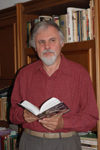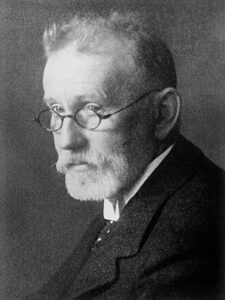By Alex Gordon


HAIFA, Israel — Paul Ehrlich performed pioneering research work in chemistry, medicine, physiology, histology, bacteriology, hematology and oncology and became the founder of immunology and pharmacology and the winner of the Nobel Prize in Physiology or Medicine for his work on immunology (1908). He invented the first effective drug against syphilis.
Ehrlich was born in 1854 in the Silesian town of Strehlen (now Poland). He was the fourth child (and only boy) in a well-to-do Jewish family. His father owned an inn and distillery inherited from his father, a wealthy merchant; his mother was a housewife. He was brought up in Jewish traditions. He received his secondary education at the Breslau Gymnasium. He spent his school vacations setting up a laboratory in his parents’ house. For his experiments, he begged reagents from an acquaintance pharmacist.
A decisive role in Paul’s choice of profession was played by his mother’s cousin Karl Weigert, a famous pathologist, one of the first to use aniline dyes for the manufacture of microscopic preparations of various tissues of the body. For Paul Ehrlich, dyes became the most important object and tool of research. He studied medicine at the universities of Breslau, Strasbourg and Freiburg.
In 1878, at the University of Leipzig, Ehrlich defended his doctoral thesis on Toward a Theory and Practice of Histological Staining. This work was one of the results of his great interest in aniline dyes. In the same year he became an assistant to Professor Friedrich Frerichs (a well-known German clinician) at the Berlin Medical Clinic, which gave him every opportunity to continue working with these dyes and staining tissues with them.
In 1883 Ehrlich married Hedwig Pinkus, with whom he had two daughters.
In 1887 Ehrlich received the title of private-docent at the Faculty of Medicine of the University of Berlin. He later became senior physician at the Charité Hospital in Berlin. He attended a meeting of the Berlin Physiological Society on March 24, 1882, at which Robert Koch, the Nobel Prize winner, reported the discovery of a bacterium, the causative agent of tuberculosis. “It was the most exciting experience of my scientific life,” Ehrlich said many years later.
In 1888, he contracted tuberculosis during a laboratory experiment because of his enthusiasm as a researcher and traveled to Egypt for treatment. The hot and dry African climate helped halt the progression of the disease, and less than two years later Ehrlich returned to Germany.
In 1890, Koch, director of the newly established Institute for Infectious Diseases, invited Ehrlich to become one of his assistants and take up immunology. In the same year he was confirmed as professor extraordinaire at the University of Berlin.
At the end of 1896, the Prussian Royal Serum Institute was founded in Steglitz near Berlin and Paul Ehrlich was appointed its director. In 1899, Ehrlich became director of the new Royal Institute for Experimental Therapeutics in Frankfurt.
In 1908, Ehrlich was awarded the Nobel Prize in Physiology and Medicine jointly with Elie Metchnikoff.
In 1910 Paul Ehrlich developed compound 606 (the number 606 showed that he had succeeded after 605 unsuccessful experiments) – Salvarsan, which was effective in the treatment of syphilis and destroyed spirochetes of a number of tropical diseases. This work laid the foundations of chemotherapy. His drug remained the primary treatment for syphilis until the invention of penicillin. One day in 1910, he appeared at a scientific congress in Königsberg and was greeted with a standing ovation. He reported how the “magic bullet” against syphilis had finally been found. Ehrlich had dreamed of inventing “magic bullets.” “Magic bullets” would be the perfect medicine to cure the disease without the danger of side effects. “We’ll learn to shoot germs with magic bullets.” – Ehrlich was fond of saying.
In 1911 the greatest distinction bestowed on Ehrlich by the Prussian state was the title Wirklicher Geheimer Rat, or Privy Councillor, with the predicate of Exzellenz. Ehrlich was an honorary member of more than 80 academies, an honorary doctor of five universities, the holder of numerous awards and medals of chemical and medical societies of different countries.
All his life Ehrlich showed interest in Jewishness, he was a member of Zionist societies. In 1913, when Chaim Weizmann met with Baron Edmund de Rothschild to discuss plans for a proposed Hebrew University in Jerusalem, the baron insisted that Weizmann obtain the “support of some great Jewish scientists, Paul Ehrlich, for example. Weizmann met with Ehrlich and convinced him to support the establishment of the Hebrew University. Ehrlich bequeathed the money to the Nordau Institute, the predecessor of the Hebrew University. In a 1918 ceremony atop Mount Scopus, when twelve foundation stones symbolizing the Tribes of Israel were laid for the University, Weizmann stated that the “sages of Babylon and Jerusalem, Maimonides and the Gaon of Wilna, the lens polisher of Amsterdam [Baruch Spinoza] and Karl Marx, Heinrich Heine and Paul Ehrlich, are some of the links in the long, unbroken chain of intellectual development.” Paul Ehrlich defeated the germs of syphilis. His “magic bullet” against the germs of antisemitism was Zionism.
When Ehrlich was at the zenith of world fame, he was offered to become a nobleman, but he refused because he did not want to change his religion. To this offer he replied, “I am a Jew and not another word. […] We have devoted our lives to science, not to the hunt for titles.” In its obituary the London Times acknowledged Ehrlich’s achievement in opening new doors into the unknown, saying, “The whole world is in his debt.”
*
Alex Gordon is professor emeritus of physics at the University of Haifa and at Oranim, the Academic College of Education, and the author of 11 books.